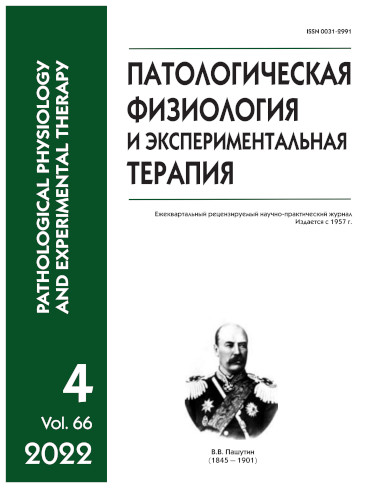The kinetics of urea in the body in chronic inflammatory liver disease
Abstract
The participation of the endogenous antioxidant, urea, in the regulation of many physiological processes and biochemical reactions explains the scientific and practical interest in studying its kinetics during illness, especially when the urea-producing function of the liver is disturbed. The aim of this work was to study the kinetics of urea in chronic inflammatory liver damage. Methods. Experiments were performed on 96 white female rats weighing 180-220 g. Chronic inflammatory liver disease was induced by subcutaneous administration of a 50% CCl4 solution in olive oil, 0.1 ml/100 g body weight, every other day, for 65 days with two two-week breaks between the 6th and 7th, 13th and 14th injections to reduce mortality. The material was collected for study on the 65th day (the last day) of CCl4 administration and on the 3rd, 7th, and 14th days after stopping CCl4. The following materials were studied: tissues of visceral organs (thyroid gland, lungs, heart, liver, stomach, duodenum, colon, spleen, kidneys); biological fluids: blood (aorta and femoral, hepatic, portal, and renal veins), bile, and urine. The urea content was determined by the diacetyl monoxime method. The activity of arginase in the homogenate and the cytosolic fraction of the liver were evaluated by the urea formation rate. Results. In chronic CCl4 hepatitis, the formation of urea by hepatocytes was disrupted as a result of a decrease in their arginase activity, which did not recover by the 14th day after stopping CCl4 withdrawal. This was accompanied by a decrease in the concentration of urea in the affected liver and an increase in its content in the blood flowing through the liver. This was due to the activation of portal, pulmonary, renal, and visceral mechanisms aimed at increasing the concentration of urea in arterial blood and in portal and renal venous blood. As a result, the urea content in the arterial blood of rats with chronic CCl4 hepatitis was elevated, despite the disruption of the urea-synthetic function of hepatocytes. At the same time, the kinetics of urea changed in both the whole body and in individual organs. Conclusion. The ability of the body to prevent a decrease in the concentration of blood urea during disruption of the urea-producing function of the liver, as caused by the prolonged action of CCl4, indicates the important role of urea in sanogenic reactions that are triggered during chronic CCl4-hepatitis.






